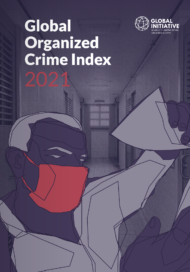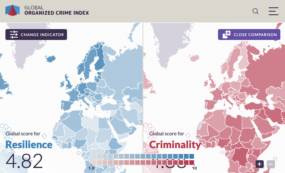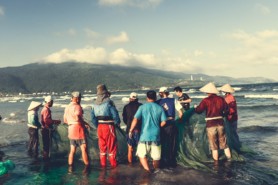Posted on 17 Jun 2022
South East Asia is a central node in the global trade of synthetic drugs. Data-driven responses are needed to counter criminality in the region.
South East Asia has a dark criminal mythology, especially in the infamous golden triangle region – the area where the borders of Thailand, Laos and Myanmar meet –, which has a long history of opium poppy cultivation and heroin production.
Over the last decade, law enforcement in the region has drastically increased seizures of synthetic drugs, including methamphetamine and crystal methamphetamine. However, and although illicit-drug usage data for the region is limited, the price, purity and availability of synthetic drugs seems unchanged at best. At worst, the wholesale and street price of some synthetic drugs such as Yaba – a low-purity amphetamine often mixed with caffeine – may have dropped.
Contextualizing the challenge of synthetic-drug and heroin production in the region has to date been difficult, especially in Myanmar. The country’s ethnic insurgency groups, such as the United Wa State Army and Shan State Army, have created large no-go areas for law enforcement, where organized crime groups operate freely. The February 2021 military coup has further degraded law enforcement cooperation.
From Yangon to Bangkok, Hanoi to Manila, law enforcement officials have sought to coordinate efforts to tackle the trade. However, they have rarely been able to quantify and qualify the global nature of the problem. The Global Organized Crime Index provides an unprecedented opportunity to fill this gap, and its data on South East Asia’s synthetic drug and heroin market illustrate its broader utility.
Source of supply
According to the Index, Asia scores the highest of all continents in terms of criminality (with a score of 5.3) and South East Asia is the sixth region in the world – out of 22 – with the highest criminality rates (5.46). In terms of resilience to organized crime, Asia is the second-lowest scoring continent (4.46) and South East Asia also ranks low with a score of 4.58.
As for the reach of its synthetic drugs market and heroin trade, Asia ranks as a clear leader, with a score almost double that of the lowest-scoring continent, the Americas. And of all regions, South East Asia ranks first and second for these markets, with Myanmar largely contributing to the high scores.
There is no doubt that large swathes of the region are vulnerable to transnational organized crime. However, all the Mekong states – Myanmar, Laos, Cambodia, Thailand, China and Vietnam – are assessed in the Index as having particularly high crime rates and low resilience mechanisms to counter it. Myanmar’s long-term internal conflict and fragility contribute significantly to this region’s challenges.
Much of the Mekong states’ responses to the challenges of transnational organized crime in general, and synthetic drugs and heroin specifically, have been highly securitized. Some governments, like those of Thailand and Vietnam, have sought to address the problem through traditional law enforcement operations, including arrests and seizures. However, although these efforts have produced substantial operational successes, the issue remains unabated.
Other countries, like Australia and the US, typically view countries in the region as sources for their illicit-drug supply problems. This focus is understandable, as supply reduction is a much easier policy challenge than seeking to minimize demand. It is for this reason that these countries’ efforts in the region focus on implementing measures that disrupt supply chains.
Cooperative responses
As the overarching policy problem here concerns criminality and resilience to it, policymakers have a number of options beyond traditional law enforcement measures. International cooperation is critical. There is a rich history of international police cooperation in the region, but this is not enough.
Precursor, and now pre-precursor, control in the broader Indo-Pacific is necessary to stem the industrial-scale production of synthetic drugs in South East Asia. The rapid expansion of the Indo-Pacific’s chemical and pharmaceutical industries over the last two decades has not been matched by enhancements in regulatory and compliance. Much could be achieved in this space.
The COVID-19 pandemic has slowed the progress of border harmonization. As the world slowly recovers from the pandemic, pressure to accelerate border and economic integration will return. To successfully mitigate the organized crime threat, countries in the region must ensure that security and compliance are critical components of any future strategy. Here, too, there are opportunities for greater cooperation.
Supply-reduction strategies are also key. Forty years ago, some 100 000 hectares of farmland in Thailand were used to cultivate opium. By 2007, the country was declared opium-free by the UN Office on Drugs and Crime. This was made possible by the Thai King Bhumibol Adulyadej, who in 1969 established the Royal Project, which provided alternative livelihoods for those involved in growing and refining opium. The ambitious project was underpinned by rigorous research on alternative crops. The Thai government and international partners then developed critical infrastructure that gave farmers growing new crops access to markets.
Although we cannot take this example as a broad solution to opium or synthetic-drug production, as many factors not present in other jurisdictions contributed to the Royal Project’s success, we can note that some measures – especially those deeply rooted in community development – result in improved security conditions and reduced drug production.
It is likely that increased precursor control in countries such as China will restrict the production of synthetic drugs in Myanmar, impacting the broader region, albeit for a short time. However, this approach will not address the underlying conditions that have allowed transnational crime to thrive. For the international community to address this issue, it will require a coordination of efforts focused on the rule of law, political stability and economic security.
Owing to the Index, policymakers now have an opportunity to globally contextualize the levels of synthetic-drug and heroin criminality in the region. Each subsequent edition of the Index will add to this evidence base and allow for tracking these problems over time. In the interim, careful analysis of the Index’s data will reveal additional insights on transnational organized crime. Now is the time for subject matter experts and policymakers to make maximum use of this research.
This analysis is part of the GI-TOC’s series of articles delving into the results of the Global Organized Crime Index 2021. The series explores the Index’s findings and their effects on policymaking, anti-organized crime measures and analyses from a thematic or regional perspective.
Subscribe to the dedicated newsletter to get regular updates about the project and the launch event



